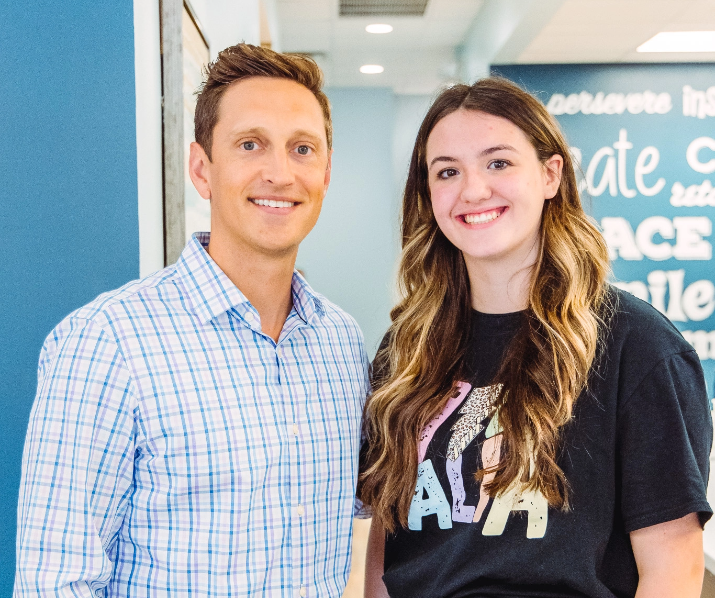
Managing The Muscles Of The Face, Mouth And Throat
Myofunctional Therapy
Oral myofunctional health depends on the relationship between the muscles of the face, mouth and throat. Keeping the mouth closed is necessary for improved breathing and proper swallowing, and it focuses on how the muscles of the face and mouth work together to keep the lips closed when the mouth is at rest. Addressing oral myofunctional disorders early is necessary to mitigate issues with dental development and overall health.
Myofunctional therapy is used to correct the improper function of the tongue and facial muscles by strengthening the tongue and orofacial muscles by teaching individuals how to engage the muscles in the appropriate position. Cosmetic improvements that happen as a result of therapy also restore confidence and self-esteem.
Orofacial Myofunctional Disorders (OMDs)
An Orofacial Myofunctional Disorder (OMD) is the underdevelopment or lack of tone in any of the muscles of the face, throat or mouth that affects the muscle system that controls speech, swallowing, eating and sleeping. Most OMDs start due to insufficient nasal or mouth breathing that has become habitual. The muscles and the orofacial functions adjust to this breathing pattern creating various OMDs. Having an OMD can impact speech development, increase mouth breathing and the teeth and jaw.
Signs And Symptoms Of Orofacial Myofunctional Disorder (OMD)
People of any age may suffer from OMDs, and they may interfere with the normal growth and development of the muscles and bones of the face and mouth. They may also interfere with how the face and mouth muscles are used for eating, talking, and breathing. Proper diagnosis allows for targeted and effective oral myofunctional therapy exercises to retrain the muscles, promote better health, and enhance the quality of life.
Individuals with OMDs often develop habits and patterns that may present various symptoms. However, just because a person has some or all of these symptoms does not mean they have an OMD. Common OMD symptoms include:
- Always breathes through the mouth or has difficulty breathing through the nose.
- Limited tongue movement.
- Eating may be messy or difficult. Babies do this when first learning to eat, but it should go away over time.
- An overbite, underbite, and/or other dental problems.
- The tongue pushes past the teeth, even when a person is not using the tongue.
- Difficulty saying some sounds, like “s” in “sun,” “sh” in “ship,” or “j” in “jump.”
- Drooling, especially beyond age two.
- Difficulty closing the lips to swallow.
Causes Of Orofacial Myofunctional Disorder
There is not a known single cause of OMDs. OMDs may be caused by several factors:
- Blocked nasal passages because of tonsil size or allergies. When the nasal passages are blocked, people may need to breathe through their mouth instead.
- Anything that causes the tongue to be misplaced at rest or makes it difficult to keep the lips together at rest.
- Sucking and chewing habits past the age of three years.

Why Is Oral Myofunctional Health Important?
Orofacial Myofunctional Disorders (OMDs) can cause many issues for those who suffer from them. The following are some of the possible consequences of untreated OMDs.
Poor Swallowing
Swallowing depends on the relationship between the muscles of the face, mouth and throat. To swallow properly, muscles and nerves in the tongue, cheeks and throat must work together. When a person swallows normally, the tip of the tongue presses firmly against the roof of the mouth, slightly behind the front teeth. Since we swallow 500-1000 times a day, improper swallowing can cause a variety of problems.
Tongue Thrust
Poor swallowing causes more damage because of the adjusted placement of the tongue when swallowing. When a person swallows incorrectly, the tongue presses against the teeth. Constant pressure from resting or incorrectly thrusting the tongue may push teeth out of place and create an open bite making it difficult to bite and chew.
Abnormal Bite
When teeth are not where they should be, it can create improper alignment between the upper and lower teeth leading to difficulties in biting, chewing, swallowing and digesting food.
Constantly Parted Lips
A person swallowing incorrectly often looks like their mouth is always open because their lips don’t naturally close on their own. To close their mouth completely, they will have to purse and tighten the muscles of the cheeks, chin and lips.
Cosmetic Issues
Weak lips develop when muscles aren’t operating normally, causing a dull, sluggish appearance. The grimacing necessary to close one’s mouth completely gives the chin a knobby appearance because these muscles are being overused.
Speech Problems
A person with abnormal muscle patterns in the mouth may suffer a lisp or have difficulty articulating sounds.
Temporomandibular Joint Disorders (TMD)
Improper oral muscle function may also lead to TMJ dysfunction
Sleep Disordered Breathing and Mild to Moderate Obstructive Sleep Apnea
Because OMDs affect breathing and swallowing, they may cause sleep-disordered breathing like snoring and mild to moderate obstructive sleep apnea since the muscles of the tongue, throat, and face are unable to reduce obstruction to the airway.
What Is Orofacial Myofunctional Therapy (OMT)?
Orofacial Myofunctional Therapy (OMT) eliminates many of the causes of poor swallowing and improper tongue placement. OMT corrects the improper function of the tongue and facial muscles. It involves strengthening the tongue and orofacial muscles by teaching individuals how to engage the muscles in the appropriate position. OMT is painless, and the exercises are relatively simple. When certain muscles of the face are activated and functioning properly, other muscles will follow until proper coordination of the tongue, and facial muscles is attained. When you see a specialist like Dr. Glass, he can determine the exact issues occurring and teach you what exercises are recommended to improve how the orofacial muscles are working.
For success in this therapy, consistent exercise every day is necessary until the patient has corrected their improper muscle pattern. It takes commitment by the patient, family. Treatment usually consists of a regular program of exercises over a 6 – 12 month period, although treatment length may vary.
Benefits Of Myofunctional Therapy
Myofunctional therapy for patients is designed to retrain and strengthen weak orofacial muscles eliminating symptoms of OMDs. The exercises are designed to:
- Increase awareness of tongue position
- Coordinate oral and facial muscles so lips, cheek and jaw muscles work together
- Improve the function of bite and jaw alignment
- Improve ability to swallow, breathe and articulate speech
Myofunctional therapy exercises are customized to each patient’s unique needs. The success of the therapy depends on the diligence of the patient. After retraining and strengthening the muscles of the face, lips, tongue and mouth, the patient will no longer have the oral myofunctional disorder and significantly improve the quality of their life.

Request Your Complimentary Consultation
Are you curious to learn more? Fill out our easy online form to request your complimentary orthodontic consultation with Dr Timothy Glass.
Keep up with the Latest At Glass Orthodontics
Stay Connected:
Let's Get Started
Visit our Virginia Office
Chesapeake
757-204-7770
200 Carmichael Way, Suite 600
Chesapeake, Virginia 23322
Hours
Monday 8:00-5:00 pm
Tuesday 8:00-4:30 pm
Wednesday 8:00-5:00 pm
Thursday 8:00-5:00 pm
Friday 8:00-2:00 pm
Visit our North Carolina Office
Elizabeth City
757-204-7770
1755 City Center Boulevard, Unit B
Elizabeth City, North Carolina 27909
Hours
Monday 8:00-5:00 pm
Tuesday 8:00-4:30 pm
Wednesday 8:00-5:00 pm
Thursday 8:00-5:00 pm
Friday 8:00-2:00 pm
